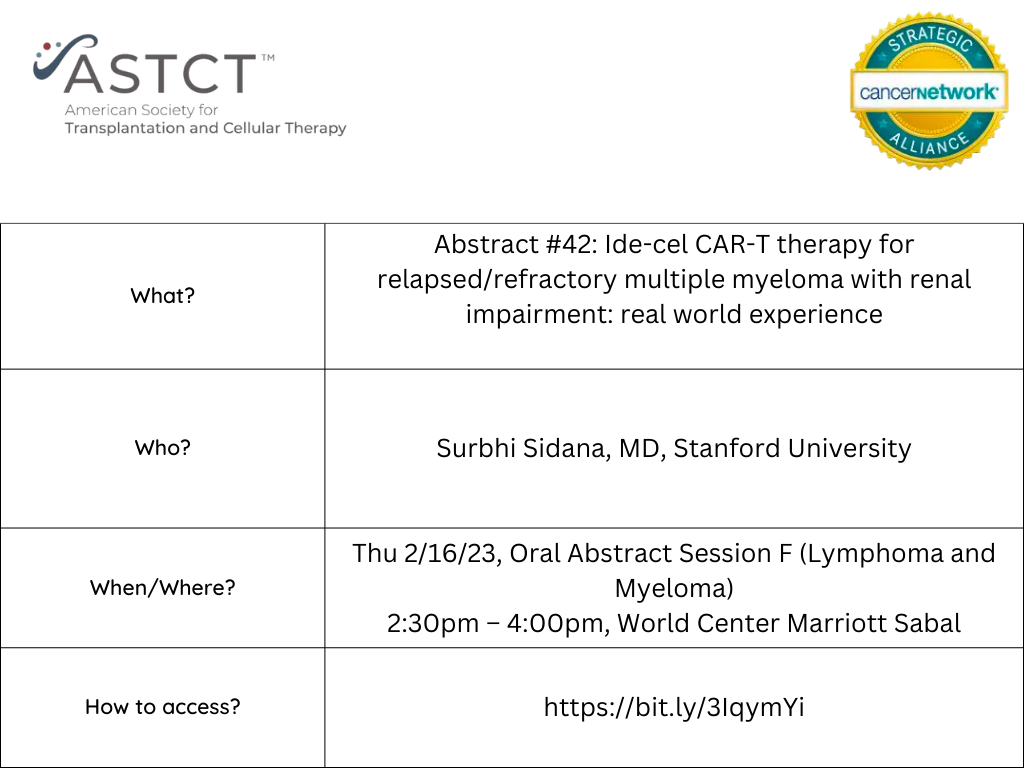Ide-cel and kidney disease: the re(n)al-world experience with BCMA CAR-T
Rahul Banerjee, MD, FACP, discusses a recent presentation from the Tandem meeting regarding BCMA CAR T-cell therapy in patients with multiple myeloma.
Abstract discussed at the Tandem Meeting

Real-world studies, while certainly not new in oncology, are particularly relevant to novel chimeric antigen receptor T-cell (CAR-T) therapies given the intertwining web of factors that factor into how well a “living drug” works: underlying disease, patient co-morbidities, T-cell function, and more. A recently published real-world analysis of idecabtagene vicleucel (ide-cel), a BCMA-targeting CAR-T therapy in multiple myeloma (MM), demonstrated that 75% of patients who received ide-cel in the real world would have been ineligible for the KarMMa trial of this drug. Among patients who are aged ≥70 at diagnosis, this figure likely surpasses 90%.
At this year’s ASTCT/CIBMTR Tandem 2023 meeting, abstract #42 (with Dr. Surbhi Sidana and Dr. Lauren Peres as co-first authors) dives deep into a particular subset of the real-world experience with ide-cel: namely, their renal-world experience encompassing a wide range of creatinine clearance (CrCL) values and underlying explanations. The authors describe 211 patients with relapsed/refractory (R/R) MM, 28 (13%) of whom had CrCL < 50 mL/min. There was no difference between patients with versus without renal insufficiency in terms of total infused CAR-T dose or progression-free survival. Unsurprisingly, renal impairment was unlikely to reverse entirely after CAR-T therapy. Grade 3+ cytopenias (typically requiring transfusions or growth factors) occurred at similar frequencies at the 3-month mark but were more common in the renal-insufficiency group 1 month after CAR-T.
We interviewed Dr. Sidana (@SurbhiSidanaMD), the presenting author, to hear a bit more about the rationale for this study and future directions based on the results. (Responses edited for clarity.)
Dr. Banerjee: Of the many patient sub-populations who were excluded from the seminal KARMMa or CARTITUDE-1 trials of BCMA CAR-T therapy in multiple myeloma, why did you choose to focus on renal insufficiency in particular?
Dr. Sidana: We focused on renal insufficiency as it affects a large proportion of patients with MM. Renal insufficiency is a common presenting symptom and, in fact, is one of the four hallmark CRAB criteria defining active myeloma as part. One fourth of patients with myeloma present with renal insufficiency at the time of active myeloma diagnosis. Several patients also develop renal insufficiency with treatment and relapse. Although we do not have exact numbers, it is likely that the proportion of patients impacted by renal insufficiency in R/R MM (where CAR-T is currently approved) is even higher than at diagnosis. Therefore, it is imperative that we do everything possible to safely deliver novel therapeutics like CAR-T to these patients. This is what motivated us to focus on renal insufficiency.
Dr. Banerjee: Excellent points all around. You noted that Grade 3+ cytopenias were more common at 1 month in the renal insufficiency cohort, but that there was no difference between cohorts at the 3-month mark. Do you have any hypotheses as to why this was the case? Perhaps due to lymphodepletion?
Dr. Sidana: It is hard to speculate as to the reason why short-term cytopenias were more common in patients with renal impairment. As you noted, this may have been due to the impact of lymphodepletion or different kinetics of CAR-T expansion in this patient population. Our data from this study are hypothesis-generating, and we hope to learn more with future investigation as part of a prospective clinical trial.
Dr. Banerjee: In your abstract, you comment specifically on patients who received reduced-dose fludarabine as part of lymphodepletion in each cohort. Did any of the patients in this analysis receive alternative regimens such as bendamustine due to the international fludarabine shortage that peaked in 2022?
Dr. Sidana: These data did not overlap with the fludarabine shortage, and all patients in our cohort received fludarabine and cyclophosphamide (Flu/Cy) for lymphodepletion. As you mentioned, fludarabine was dose-reduced in the majority of patients with renal insufficiency. Because institutional practice varied between centers, we do not know what the optimal dose reduction of fludarabine is in this population. For this reason, we are planning a Phase 2 trial of ide-cel in this patient population with uniform dose reduction of fludarabine based on CrCL.
____________________________________________________________________
The Myeloma CAR-T Consortium’s work fills a valuable gap in our understanding of whether CAR-T therapy is safe and effective in patients with kidney disease. Indeed, their analysis even included a patient who was on hemodialysis at the time of CAR-T infusion. Other abstracts being presented at #Tandem23, for example abstract 245 (“Fludarabine exposure impact on safety and efficacy of ide-cel in R/R MM”, being presented by Dr. Frederick Locke and colleagues), also show that fludarabine dose intensity – a common question in patients with renal insufficiency – does not appear to impact outcomes with ide-cel in MM.
Oncologists Reflect on Pandemic's Lasting Impact on Cancer Care
Hear from leading cancer experts about the lasting impact the COVID-19 pandemic has left on clinical practice.